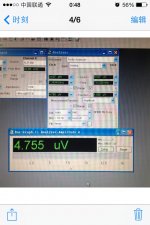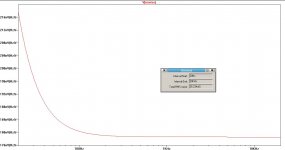A bit if a gap in my expertise here.
OK, My amp has an output of 22V RMS
Spice tells me my noise density is 112 nV/sqrt Hz
Divide 112 by sqrt of 20K or 141, I get .794nV
Here is where I go wrong. I am off by a factor of 1000.
If I plug this into 20 log (22/.794 ee-9) I get 208.
Of I do 20 Log (22/.794 ee-6) I get 148 dB which is the believable value.
I tried to follow Cordell in his spice section and I believe his example is off by 10, so even more confused.
Maybe I am totally confused.
OK, My amp has an output of 22V RMS
Spice tells me my noise density is 112 nV/sqrt Hz
Divide 112 by sqrt of 20K or 141, I get .794nV
Here is where I go wrong. I am off by a factor of 1000.
If I plug this into 20 log (22/.794 ee-9) I get 208.
Of I do 20 Log (22/.794 ee-6) I get 148 dB which is the believable value.
I tried to follow Cordell in his spice section and I believe his example is off by 10, so even more confused.
Maybe I am totally confused.
OK following this.
Spice gives the output noise density.
I need to reference the input, so
divide spice supplied number by the system's gain. 112nVperHz / 27 is 4.148nVper Hz
Multiply by the number of sqrt increments, or 141 gives me 585nV
20 log Vout / Vnoise or 20 log (22/585 ee-9 is 151 dB
Do I have this? Makes more sense today.
Spice gives the output noise density.
I need to reference the input, so
divide spice supplied number by the system's gain. 112nVperHz / 27 is 4.148nVper Hz
Multiply by the number of sqrt increments, or 141 gives me 585nV
20 log Vout / Vnoise or 20 log (22/585 ee-9 is 151 dB
Do I have this? Makes more sense today.
Even that might be optimistic. You need to add the voltage noise component, the current noise component (in, pA per rt Hz, times Rs gives volts), and the Johnson noise of the source resistance itself. All 3 components add RMS. If the source resistance is low (like 10-20 ohms) the last two aren't really big players, but get it up into the k ohms and it can doiminate.
4.something is about the noise level of a good low noise opamp.
4nanovolts/root Hertz is the medium frequency and high frequency levels for a 5334.
Expect a low noise discrete Power Amp to be in the range 8nV to 20nV per root Hertz. Excluding avoidable Hum and buzz.
A chipamp is of the order of 20nV to 100nV per root Hertz.
Including avoidable Hum and Buzz can make those Power Amplifier number tens of times worse.
That's why I keep asking for Numbers when Builders claim their new builds have no Hum.
To me 1mVac of hum is NOT = no Hum.
<0.1mVac is my definition of no Hum.
~0.3mVac is hum, but almost inaudible.
20nV/root Hz is 0.08mVac in a 27 gain Power Amplifier over the 20Hz to 20kHz frequency range
4nanovolts/root Hertz is the medium frequency and high frequency levels for a 5334.
Expect a low noise discrete Power Amp to be in the range 8nV to 20nV per root Hertz. Excluding avoidable Hum and buzz.
A chipamp is of the order of 20nV to 100nV per root Hertz.
Including avoidable Hum and Buzz can make those Power Amplifier number tens of times worse.
That's why I keep asking for Numbers when Builders claim their new builds have no Hum.
To me 1mVac of hum is NOT = no Hum.
<0.1mVac is my definition of no Hum.
~0.3mVac is hum, but almost inaudible.
20nV/root Hz is 0.08mVac in a 27 gain Power Amplifier over the 20Hz to 20kHz frequency range
Last edited:
I've seen as low as 2nv/rt Hz for state of the art op amps, and 1.7nv/rt Hz is the theoretical limit for a bipolar transistor. Something like that on >100 ohm source resistance (inclusing the feedback of course) is d*** quiet. Stick your ear up to the tweeter and hear NOTHING kind of quiet.
In LTspice, you specify a noise simulation. Run it, click on the output of your circuit and a graph of noise versus frequency will appear. It will most likely rise significantly at lower frequency, say below 100Hz. Now control click on the graph label. A little window will appear. Type in the stop and start frequencies. LTspice will then calculate the total RMS noise voltage for you.
As an example, I get 25.234uV for a circuit I am working on, for 20Hz to 20kHz. Peak output voltage is 34.6217V, or 24.28V RMS.
S/N ratio is 20 * log(24.28/25.23E-6) = 119dB. Not bad
As an example, I get 25.234uV for a circuit I am working on, for 20Hz to 20kHz. Peak output voltage is 34.6217V, or 24.28V RMS.
S/N ratio is 20 * log(24.28/25.23E-6) = 119dB. Not bad
better than "not bad" !.......................As an example, I get 25.234uV for a circuit I am working on, for 20Hz to 20kHz.....................
S/N ratio is ............119dB. Not bad
Excellent for a power amplifier, ~6.6nV/rtHz (gain=28x).
So amazing I can't believe your numbers.
Just read the THD+N VS VOUT curve, the 100mV output is ~0.004% THD+N, here 0.004% is all depended on noise. So, the un-weight noise is 100mV*0.004%, that is 4uV
No trick can make here.
Last edited:
Those results (which I can't read from the plots) seem contradictory.
4uV is stated for un-weighted noise and 2.95uV is shown for A weighted noise.
Here is the un-weight noise for that unweighted THD+N vs Vout curve.
The bandwidth is <10Hz to 22kHz. When the bandwidth set to 22Hz to 22kHz, the noise will be further reduced a little more.
Attachments
Last edited:
better than "not bad" !
Excellent for a power amplifier, ~6.6nV/rtHz (gain=28x).
Thanks.
The design is quite orthodox, a Blameless with Darlington plus cascode VAS and two-pole compensation. I just sweated the details of calculating component values.
Here is the output of the noise analysis. You have to ctrl-click on V(onoise) in red to bring up the dialog. A bit of a hidden feature in LTspice but lucky for us Bob Cordell reveals it in his book.
Attachments
better than "not bad" !
Excellent for a power amplifier, ~6.6nV/rtHz (gain=28x).
If reality is only a lot worse, they yes, very happy. Same with the distortion it simulates at .0009 1-9 @ 20K. If it comes out in the real world as < .01 I will be doing handsprings.
Sim is a perfect power supply and the models are all suspect. I think the resistors are only Johnson noise. Just doing the simulation of the topology before fixing things for the real world like MOSFET drivers so I don't starve the out bases without going to a tripple output, a few protection features, further stability margin, etc., I did have it once at .00002.
Don't understand why it simmed so well with too small drivers and starving the outputs. So much to learn.
- Home
- Amplifiers
- Solid State
- SNR from noise density



